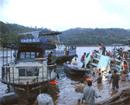
Guwahati, May 1: Rescue operations continued in the Brahmaputra in Assam Tuesday, a day after a ferry capsized in the river killing nearly 70 people, but with at least 150 still missing the death toll was expected to rise, officials said.
On Tuesday, the district administration pressed into service a helicopter of the Indian Air Force (IAF) to step up the rescue operations in Monday's incident, in which a storm hit the ferry, causing it to drown in Lower Assam's Dhubri district.
Abdul Aziz, a survivor, said there were over 300 passengers on the ferry. “The storm was so strong that it broke the ferry into pieces,” he said.
A district administration official said: “The casualty might go up as we are yet to ascertain the exact number of passengers on the ferry. As per our information, about 240 passengers bought tickets but there were passengers without tickets too.”
“We have taken all possible measures to search and rescue victims.”
At least 68 people died and over 150 are still missing after the ferry, which was on its way to Madattari under Fakirganj police station from Dhubri town, capsized in heavy storm in Brahmaputra river Monday evening.
The Border Security Force (BSF) and the National Disaster Rescue Force (NDRF), which started rescue operations immediately after the incident along with local people, could bring ashore 80 people till Monday night. Some passengers managed to swim to the river bank.
Prime Minister Manmohan Singh, a Rajya Sabha MP from the state, Monday expressed shock about the loss of lives in the boat tragedy and conveyed his deepest condolences to the near and dear ones of those who lost their lives, said an official release.
He has also instructed officials for all possible assistance to the state government in relief operations and also for assistance from the Prime Minister's National Relief Fund to families of the deceased.
The prime minister spoke to Chief Minister Tarun Gogoi to convey his condolences and express solidarity with the people of Assam.
An official communiqué from the chief minister's office said Gogoi has directed the chief secretary and principal secretary, revenue and disaster management department, to expedite rescue and relief operations.






Comments
Add new comment